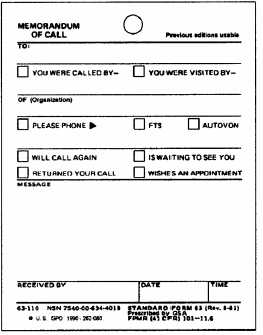of equal importance. Often, problems that are
brought to the chaplain result partly from failure to
communicate or a partial breakdown of the chain of
command.
Be
aware
of
obstacles
to
free
communication and act where you can to do your part
in avoiding these obstacles in your office setting.
Within the Navy, communication takes several
forms such as oral or written communication,
meetings, and telecommunication messages. In the
following sections, let’s take a look at some of these
forms.
ORAL
When speed is important or when several people
must get the same message, oral communication may
be the most efficient avenue. Passing on a clear idea
and listening carefully are important factors in
successful oral communication. Listening is critical in
passing or receiving information. If you feel that the
message is not understood repeat it, or ask the sender
to repeat it, word for word.
When receiving oral communication by phone
and the message is intended for someone else, write it
down using a Memorandum of Call, Standard Form
63, such as the one shown in figure 6-4. This form
clearly identifies all the essential information you will
need to pass from the caller to the intended recipient.
Figure 6-4.—Memorandum of call.
WRITTEN
When you or the chaplain want to avoid
mistakes, to keep an essential record, or to confirm
an agreement, decision, or reminder, you should use
a form of written communication. In all written
communications, the most critical factor is to make
sure both the words and style of the message fit the
language level and ability of the person to whom it is
addressed. This is particularly true in naval writing
which demands organized, active, and natural
writing.
The Department of the Navy Correspondence
Manual, SECNAVINST 5216.5C, is your guide for
quality and style in writing, correspondence formats,
and paper work management. Use SECNAVINST
5216.5C as your official guide to format standard
letters, multiple-address letters, endorsements,
memorandums, business letters, addresses on
envelopes, personnel matters, and correspondence
management. In addition, SECNAVINST 5216.5C
clearly identifies the military and civilian models of
address as well as stock numbers for forms and
envelopes you will use in your daily administrative
activities.
MEETINGS
The chaplain may require you to set up
meetings. The meeting of interested persons is a
common medium for communications. The RP must
see that each person attending knows the reason and
the agenda. Is the attendee supposed to listen only or
to listen and participate? Good practice calls for
meetings to be defined, to start on time, to adhere to
a planned schedule, to include only those who need to
attend, and to have relevant minutes distributed to
those to whom they will be of importance.
TELECOMMUNICATION MESSAGES
The Naval Telecommunications System provides
a message service to its users within the Navy.
Message traffic is often essential to the functioning of
the chaplain’s office. Users must prepare naval
messages
in
a
standard
form.
The
Telecommunications
Users
Manual
(NTP3(H))
contains detailed procedures for drafting and typing
naval messages. In fact, the Navy expects you to
follow this manual so exactly that “all outgoing
messages of ROUTINE precedence that are not
prepared according to ACP121 US SUPP-1, JANAP
128, and this publication, or contain errors of any
kind that will impede processing and/or delivery will
be returned to the originator with notification of corrective
action required.” Common practice will increasingly
6-17

